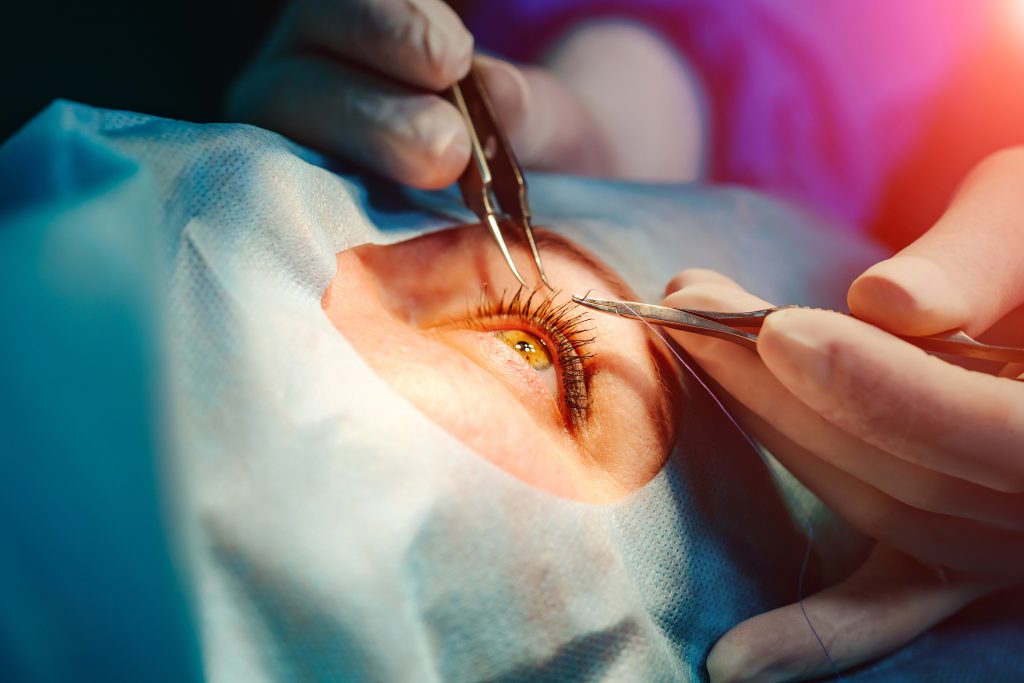Introduction
Ophthalmology is a branch of medicine that deals with diagnosing and treating eye disorders. The use of laser technology in ophthalmic surgery has witnessed a significant advancement in recent years. Suture, one of the oldest and most popular methods of ligation in ophthalmic surgery, has been falling out of favour with the introduction of laser-assisted ligation (LAL) techniques. Many ophthalmic surgeons view sutures as an ‘aging method’ that is not useful in surgical precision. However, this may no longer be the case, as new research shows new uses for sutures that make them relevant again in ophthalmic surgery. Despite cataract surgeries being performed without sutures, suturing is still an essential skill that every eye surgeon must master well. To understand why this is the case, we must look at what suture is and how it works. Part of this skill requirement arises from knowing and deciding which suture to use. In this blog post, we will explore why suture is still relevant in ophthalmic surgery, even in the age of lasers.
What is a suture?
Suturing is a method of tying off blood vessels to prevent bleeding and hold a wound together till the natural healing process is sufficiently established. It consists of a thin, long thread that is twisted into a loop and either sewn into the tissue or tied with a knot. The introduction of sutures in ophthalmic surgery dates back to the mid-1800s when it was used to stop bleeding after surgery to the blood vessels. A suture is commonly used in ophthalmic surgery to close incisions or wounds. Since the eye is a delicate organ, sutures provide the necessary support to the surrounding tissue. It helps keep the wound closed and prevents scar tissue formation. This is especially important in the case of cataract surgery, which is the most common eye surgery performed worldwide.
Why Does Suture Matter in Ophthalmic Surgery?
Laser technology has revolutionized the field of ophthalmology, but it has its limitations. Some ocular conditions and anatomies may not be amenable to laser surgery and therefore require traditional suture techniques. For example, laser surgery is not suitable for certain types of retinal detachment, and a suture is used to repair the detachment. Therefore, sutures can be used in conjunction with laser surgery.
As already mentioned above, laser technology may not be for everyone.
- Factors like family history, medical conditions, and lifestyles make some people non-eligible for laser treatment.
- People with autoimmune diseases, with an inability of the body to heal or prone to infections, are not eligible for laser treatments, i.e., diabetic patients who take longer to heal or people with high blood pressure and hormone imbalance.
- Laser treatment may cause dry eyes.
- In case of cataracts, a small incision is becoming common. However, for people with dense lenses, the traditional procedure called the Extracapsular Cataract Extraction (EECE) is advisable.
- Age is also one of the deciding factors. Patients below 18 years are not good candidates for laser treatment as their vision changes over time, and the laser is permanent.
- Those taking certain medications may experience the side effects of laser treatment.
How do Sutures work in Ophthalmic surgery?
Suture plays a crucial role in closing incisions, supporting the surrounding tissue, and in some instances, providing additional stability and strength to the repair. With the advancement in suture materials, using sutures in ophthalmic surgery is becoming more comfortable and less invasive for patients. Sutures will continue to be an essential tool for ophthalmic surgeons for many years.
In addition, the suture is often used with other technologies, such as laser surgery, to provide the best outcome for the patient. For example, a laser may be used to make an incision, and then a suture is used to close it. This allows the surgeon to take advantage of the precision and control of sutures while also benefitting from the benefits of laser technology.
Advantages of Suture in Ophthalmic Surgery
The advantages of sutures in ophthalmic surgery are many. One of the key advantages of sutures in ophthalmic surgery is their versatility. The suture can be used in various procedures, from simple incision closures to complex reconstructions. Suture takes less time to tie than laser. For example, sutures can be used to repair a detached retina, to close a wound after a corneal transplant, or to reattach a detached iris. It is safe for eyes with cataracts, glaucoma, etc.
Another advantage of sutures is their precision. Suture allows the surgeon to make tiny and precise incisions, which is especially important in the delicate structures of the eye. The suture also allows the surgeon to control the tension on the wound, which is crucial for proper healing.
The suture is also a reliable and long-established technique used for many years in ophthalmic surgery. Surgeons are highly trained and experienced in suture techniques, which means that the risk of complications is low. Furthermore, the materials used for suturing have also improved over time, becoming stronger, more flexible, and less likely to cause irritation. Suturing does not cause pain or inflammation.
It’s also important to note that suturing is a cost-effective option for patients as it does not require special equipment. Suture materials are relatively inexpensive, and the procedure is typically less expensive than laser surgery. Furthermore, the suture is also a good option for patients in remote or underserved areas, where access to advanced technology may be limited.
In addition, sutures can provide additional stability and strength to the repair in certain cases. For example, the suture is used in corneal transplantation surgery to hold the transplanted tissue in place. The suture also helps to prevent the transplanted tissue from being dislocated. Sutures can be used on eyes with very weak or no muscle function.
It’s important to note that the use of sutures in ophthalmic surgery has also improved over the years. With technological advancement, suture materials have become stronger, more flexible, and less likely to cause irritation or allergic reactions. Dissolvable sutures are also becoming more common, which eliminates the need for suture removal and leaves no scar tissue.
Conclusion
In conclusion, while laser technology has revolutionized the field of ophthalmology, the suture is still an essential tool in ophthalmic surgery. The suture is still relevant in ophthalmic surgery in the age of lasers because of its versatility, precision, reliability, and cost-effectiveness. While laser technology has revolutionized the field of ophthalmology, suture remains an essential tool for ophthalmic surgeons to provide the best outcome for their patients.
In case you are a caregiver of a patient who is scheduled for ophthalmic surgery, it’s important to understand the suture’s role in the procedure. It’s also important to ask your surgeon any questions you may have about the use of sutures in surgery. Remember, an informed patient is a more confident patient.
FAQs
Q: Is suture used in all ophthalmic surgeries?
A: No, sutures are not used in all ophthalmic surgeries. Some procedures, such as laser surgery for cataracts, do not require sutures. However, the suture is commonly used in many ophthalmic surgeries, such as traditional cataract surgery, retinal detachment repair, and corneal transplantation.
Q: Does suturing hurt?
A: The use of sutures during surgery is typically done under local or general anaesthesia, so the patient should not feel any pain during the procedure. After the surgery, there may be some discomfort or pain, but this is usually mild and can be managed with medication.
Q: How long does it take for sutures to heal?
A: The healing time for sutures varies depending on the type of surgery and the patient’s immunity and response to the healing process. The sutures are generally removed within a few days to a few weeks after the surgery. The body will absorb dissolvable sutures over time. Your doctor will give you detailed information about the healing process.
Q: Will I have a scar after the surgery?
A: Incisions made during ophthalmic surgery are typically tiny and are placed in areas that are less visible to the naked human eye. This means that the scarring is usually minimal and not noticeable. However, it’s important to keep the incision area sterile and clean and follow your surgeon’s post-operative instructions to minimize scarring.
Q: Are there any risks associated with sutures?
A: As with any surgical procedure, there are risks associated with using sutures. However, these risks are generally low, and most patients experience no complications. Some risks include infection, bleeding, and allergic reaction to the suture materials. It would help if you inform your surgeon about your allergy history, and they will discuss these risks before the surgery.
Q: Can I resume my normal activities after the surgery?
A: The recovery time from an ophthalmic surgery varies depending on the type of surgery and the patient’s healing process. Your surgeon will give you specific instructions on when to return to work and normal activities. Usually, you will need to avoid any heavy-duty impactful, or strenuous activities and keep your eye protected for a few weeks after the surgery.





Comments are closed.